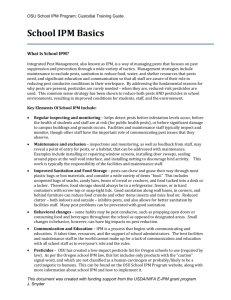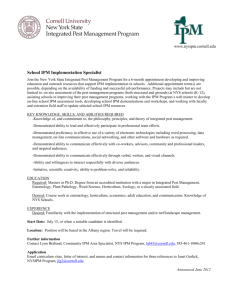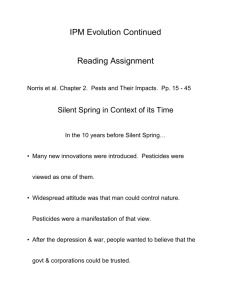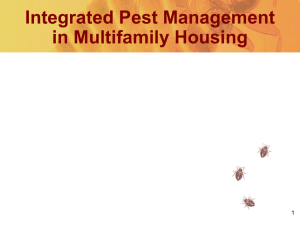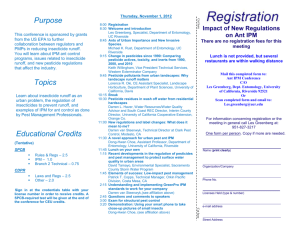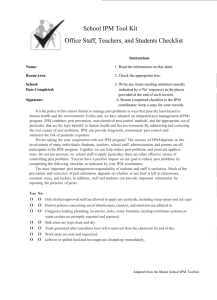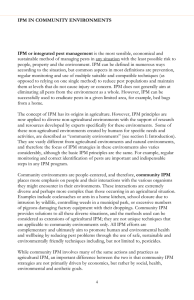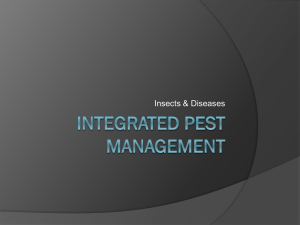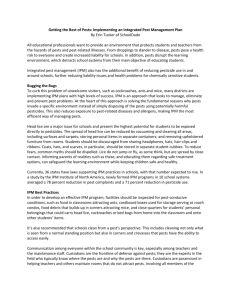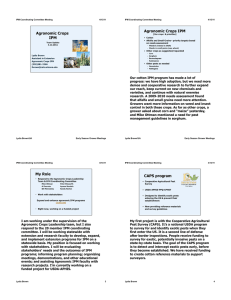Integrated Pest Management in the 21st Century
advertisement
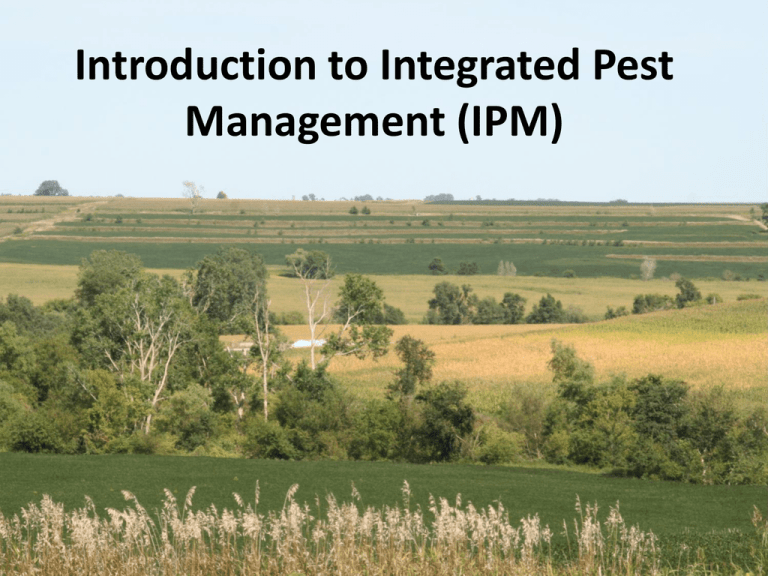
Introduction to Integrated Pest Management (IPM) Key points of IPM • Integration – Harmonious use of multiple methods to control single pests or pest complexes • Pest – An organism detrimental to humans, including: invertebrates, vertebrates, weeds, and pathogens • Management – Decisions based on ecological principles and economic and social considerations Kogan, M. 1998. INTEGRATED PEST MANAGEMENT: Historical Perspectives and Contemporary Developments, Annual Review of Entomology. Vol. 43: 243-270. Key points of IPM • IPM is a multidisciplinary endeavor • • • • • Agronomy (crop and soil science) Entomology (insects: pests and beneficial) Plant pathology (plant diseases) Economics (decision-making) Agricultural Engineering (machinery, grain handling, etc.) • Climatology (weather trends and effects) Kogan, M. 1998. INTEGRATED PEST MANAGEMENT: Historical Perspectives and Contemporary Developments, Annual Review of Entomology. Vol. 43: 243-270. History • ~2500 BC: The element sulfur was found to help control mite and insect populations • ~1500 AD to present: some plants found to generate insecticidal—and more recently— herbicidal compounds – Pyrethrum (pyrethrin - insecticidal) – The Neem tree (NEEM - insecticidal) – Bottlebrush plant, Callistemon sp. (herbicide Callisto) History • Late 1800s: inorganic compounds used for insect and fungal organism control, including: – – – – – Paris green (copper acetoarsenate) Bordeaux mix (copper sulfate and hydrated lime) Lead arsenate Creosote (coal tar derivative) Sodium hypochlorite solutions (bleach) History • 1939 (dawn of the modern insecticide era): DDT recognized as an effective insect control • Late 1940s (post WWII): the advent of “chemical” pesticides including 2,4-D • 1948 Warfarin™ registered as a rodenticide (and later -in the early 1950s- as an anticoagulant in human medicine) History • 1962: Silent Spring published • • 1967: the term “IPM” first used History • 1970: the United States Environmental Protection Agency (EPA) was founded • 1979: the Iowa State University IPM program began • 1993: call for 75% of U.S. crop acreage grown under IPM principles (by 2000) History • 1996: Roundup-ready® soybeans introduced in the U.S. By 2005, 87% of commercial U.S. soybean acres were Roundup-ready® varieties • In 1998 Roundup-ready® corn introduced in the U.S. • 2000s: U.S. farmers now apply over 1.2 billion pounds of pesticides annually • Today: with increasing knowledge of pests, crops, and improving technologies, fieldspecific management is possible IPM 1. What is “normal?” - Is it really a problem? IPM 2. What is the problem? • Proper identification is critical; that is why it is the first step. 3. How and what does the pest attack? • Only the plant of interest affected? • Parts of plant affected? • Patterns in field? Kogan 1998 IPM 4. How many pests are there? • Is it too early or too late to control? • Management must be at the correct time to maximize effectiveness. Daylily plants with aphids 5. Determine an action threshold • How many pests are too many? • Economic, health, and aesthetic threshold Kogan 1998 IPM 6. Choose appropriate management tactics • For many pests, there are several management options to consider. 7. Review your work: Was the management effective? • • • • Did actions do what you wanted? Was the method itself satisfactory? Were there any unintended side effects? What will be done in the future for this pest situation? Kogan 1998 Three important components • Economic injury level – Lowest population density that will cause economic damage • Economic threshold – Population size large enough to trigger an action to prevent an increasing pest population from reaching the economic injury level • General equilibrium position – Average density of a population over time Stern et al. 1959 Costs vs. Benefits of a Practice Costs • Product cost • Fuel • Labor • Marketing options • May increase crop damage from secondary pests Spider mite damage to soybean Costs vs. Benefits of a Practice Costs • Product cost • Fuel • Labor • Marketing options • Predisposition to secondary pests Benefits • Yield (economic) • Quality (economic) • Appearance (aesthetics) • Human/livestock health • Legal issues • Acceptance of resultant commodity by end users • Ease of mind What has changed in Iowa? • Fewer farm operators, yet the same acreage • Fewer ag retailers, yet the same acreage • Increased decision-making by someone other than the grower or pesticide applicator • Rapidly emerging crop alternatives and demands (biofuels, special-purpose crops) • Increased community and regulatory pressure • Increased options (products/formulations) • Greater concern about product availability and future costs Iowa Farm Operators 140,000 120,000 110,000 100,000 90,000 80,000 70,000 2005 2002 1999 1996 1993 1990 1987 1984 1981 1978 60,000 1975 # of farm operators 130,000 2007 2005 2003 2001 1999 1997 1995 1993 1991 1989 1987 1985 1983 1981 1979 1977 1975 # of acres Average Iowa Farm Size 380 360 340 320 300 280 260 240 220 200 What hasn’t changed? • Ultimate goal of IPM: Increase responsible pesticide use. – – – – Don’t apply when it isn’t needed Apply effectively when it is needed Weigh and apply alternative treatments wisely Know what happened afterward What hasn’t changed? • Economics is important, and always will be – Farming success is based on making a profit, and if you don’t, your operation isn’t sustainable. • Habits of growers and applicators – Change is difficult and scary. – Even inefficient practices can be comfortable – we know how they work! What hasn’t changed? • Knowledge gaps: may have changed but they still exist—and always will • Example: Does spraying a fungicide on corn that has no disease symptoms produce an economic benefit? What hasn’t changed? • Knowledge gaps: may have changed but they still exist—and always will • Yield saved by management isn’t known— you don’t know what you prevented happening! – Leaving check strips to test management effectiveness answers questions. – Observing effects if you don’t have test strips also can answer questions. What hasn’t changed? • Knowledge gaps: may have changed but they still exist—and always will • Trust and relevance of “information sources” – – – – What makes a good advisor good? Can you believe everything you hear equally? Are there ethical concerns? Just because it is in print doesn’t make it correct. Summary • Several factors drive decision-making on farms Habits Aesthetics (looks) Experience Peer pressure Fears Time Environment Economics Access to information • By identifying and learning about a pest, more focus can be applied to the environmental and economic considerations

